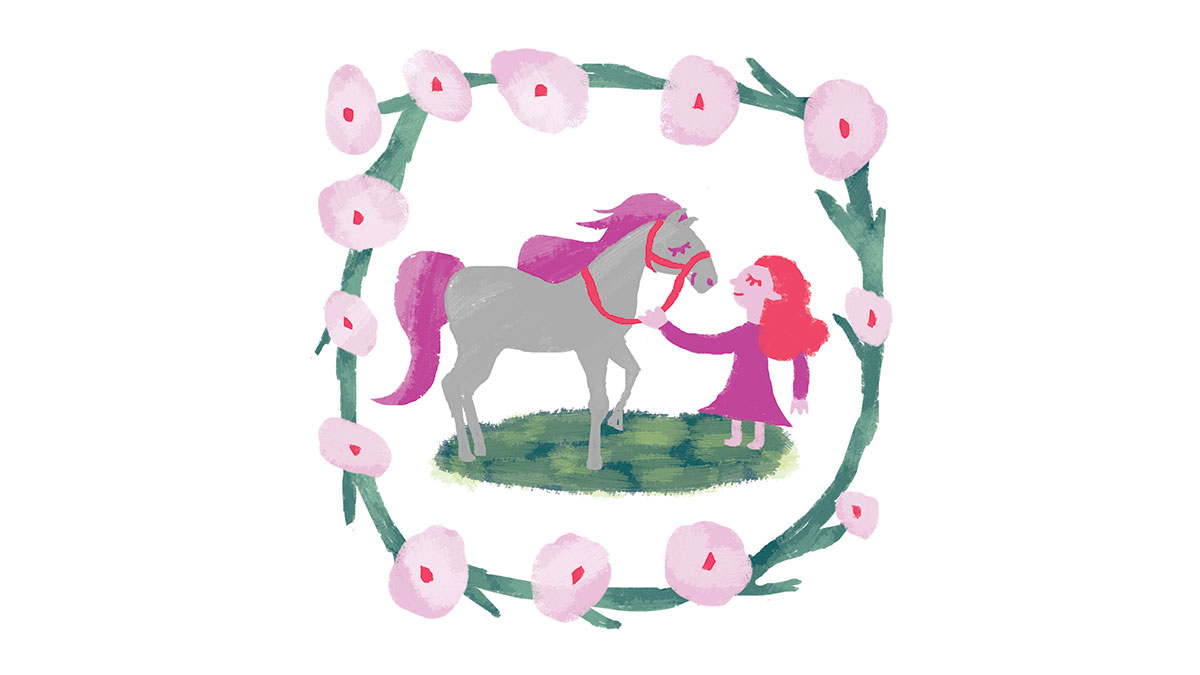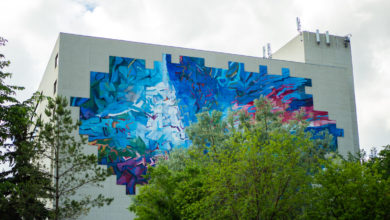Therapeutic Riding in the River Valley
 Alex Patterson
Alex PattersonSteel used to compete in show jumping. The big, grey “old man” now spends his days in Edmonton’s river valley. He’s one of about 20 horses working with disabled riders at Little Bits, Edmonton’s therapeutic riding organization.
For 40 years, the organization has allowed disabled individuals to ride horses like Steel. From the back of a 1,000-pound animal, disabled riders can grow their sense of autonomy and enhance their understanding of how living things work. It’s stimulating too — for physically disabled kids, horseback riding is a lot more interesting for strengthening core strength than simple sit-ups, according to riding program administrator Linda Rault.
“For a little person, especially for someone in a wheelchair, who is now sitting on a horse, this is the first time in their life they can look down on other people instead of looking up all the time,” she says.
Little Bits serves those who are disabled. Its youngest riders are three years old, with the oldest being more than 70. All riders live with some form of disability: cerebral palsy, Down’s syndrome, paralysis, autism, or a number of different conditions.
“We get kids coming in that are absolutely terrified,” Rault says. “Sometimes, literally, we have to pick them up and carry them (onto the horse) while they’re kicking and screaming. It’s not pretty. But within 30 seconds, everything changes. Within 10 minutes, they’ve got a big smile on their face. At the end of the lesson, they’re crying again because they don’t want to get off.”
The disadvantage of therapeutic riding it the demand. Little Bits’ wait list is enormous — more than two years long, Rault says. When the organization started out in 1975, it only had 16 riders. Now, it works with roughly 125 riders every year. With less than a 10 per cent turnover rate, most riders come back to the program every year.
The therapy riders receive is more of a byproduct of being on the horse — animal movement prompts riders’ balance to improve and hand-eye coordination to become more accurate. Riders feel sensations of relaxation and independence. Kids in the program might feel pride that they’re doing something different from their brothers and sisters. And, Rault says, horses don’t really see their riders as people with disabilities.
“Like any animal, horses are just non-judgmental,” Rault says. “Horses don’t look at the kids like, ‘Oh you’re in a wheelchair, oh you’re different.’ Horses just see the kids as another person.”
Volunteers like U of A student Camila Hurtado never learn what disability the riders they work with have — that’s confidential. One of Hurtado’s closest riders, a little girl who rides Steel, just “gets distracted very easily.”
Hurtado’s enthusiastic rider talks about everything and anything. At the beginning of her training, it was difficult to hold a conversation with her because she was eager to talk about some any topics at once. Steel, Hurtado and another volunteer were tasked with keeping the little girl focused. The little girl started out by moving Steel’s reins too much (he’s very calm and patient). A year into training, the little girl began to remember Hurtado’s name — she had been too distracted to learn it earlier.
“It’s something you don’t think about but it’s a huge step, knowing who all the people around you, and their names, are,” Hurtado says. “I just think, oh my God she knows my name. It feels great.”
Three years in, the little girl learned how to focus on what’s directly around her during “horse time.” Hurtado is proud that the little girl now rides independently, without needing to physically lead Steel around.
“Just because (people with disabilities) don’t interact in the ways of social norms, it doesn’t mean they’re not capable of achieving great things,” Hertado says.
As a volunteer, Hurtado is the “leader” of her team. In an hour-long lesson, she guides the horse and rider through the arena, with the direction of the riding instructor. The team also has a “sidewalker,” which flanks the horse as it walks through the arena and gives extra support to the rider.
For hearing-impaired riders, sidewalkers give extra direction. For the nervous, sidewalkers may just give emotional support. For “flight risk” riders — those who might dismount at any time, without warning — two sidewalkers work to make sure the rider doesn’t suddenly dismount.
Some riders, once advanced enough, may compete in Equine Canada’s Paralympic video competitions. Little Bits competitors execute a series of tasks on horseback from the comfort of the Whitemud Equestrian Centre. They’re judged against riders from across Canada for a minimal cost.
Horses must interact with four or five people in a lesson, so animals in the program need to have “super minds,” Rault says. For a prey animal like a horse, having an instructor, leader, sidewalker, and rider all in the same space can cause great anxiety. But the calm horses of Little Bits are selected because of their high tolerance. With a 12-hour work week and plenty of grooming and attention, the horses have a pretty good working life. Horses also have one day a week to decompress without any human handling.
The barn that Little Bits works in has been standing for roughly 60 years. Its old walls are covered in history — photos of the community line walls for guests to see. There’s a memorial for horses in the program that passed away. The city has decided to build a new, revamped barn this spring, with a completion date in the fall of 2017. It’s going to be insulated, allowing Little Bits to operate year-round instead of just in the spring and fall. Because as Rault says, “nothing therapeutic happens when little bodies are cold.”
In the new facility, volunteers will continue to gain valuable equine experience. For Hurtado, finding horse experience required active effort after moving to Alberta from her family’s dairy farm in Ecuador. She started at Little Bits in Grade 11 and carried that interest into her studies of animal health — and hopefully veterinary medicine after graduation. Even though Hurtado can’t ride the horses at Little Bits, she says working around them is enough. It’s certainly helped her already, in landing a job with the racehorses at Northlands for a summer. But the experience has also helped her on a personal level, in contributing to her overall self-esteem and understanding of how people change over time.
“Things aren’t going to change from one day to the other,” Hertado says. “Give people time, give horses time — it might take two weeks or a couple years — but they will get to that point where they’re comfortable and they’re fine.”
In her academic life, Hurtado is Vice-President (Animal Health) of the U of A’s Pre-Vet/Animal Health club, or as she calls it, the “animal lovers’ club.” Members are granted opportunities to work with numerous animals — sheep, dogs, cats, and horses. The group officially volunteers with Birch Bay Ranch once a year for a trail ride. Some group members, like Hurtado, volunteer with Little Bits for a longer-term experience, a must for those applying to veterinary school.
Other volunteers that come to Little Bits were once riders in the program themselves. It’s happened about five times, Rault says. Seeing the rider become independent enough to sidewalk and later lead a team is rewarding..
“It’s almost a full circle,” Rault says. “They’re giving back to the community that kind of brought them up.”




